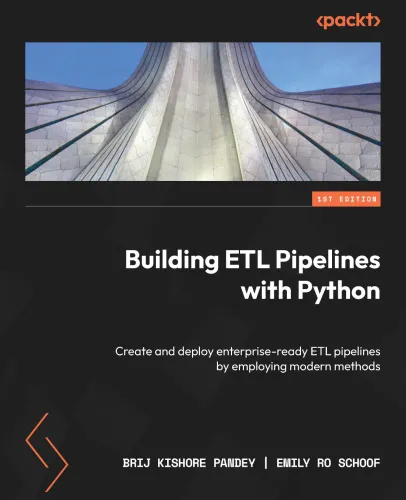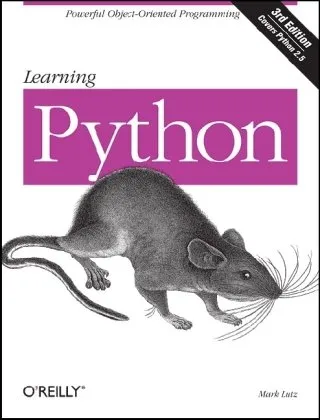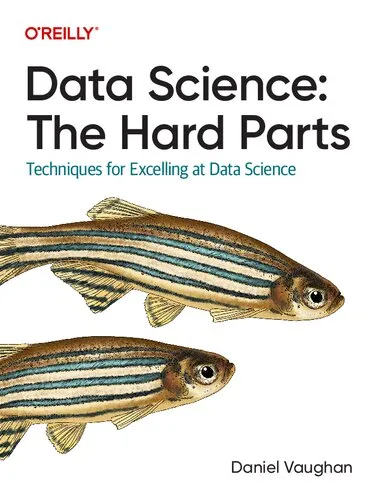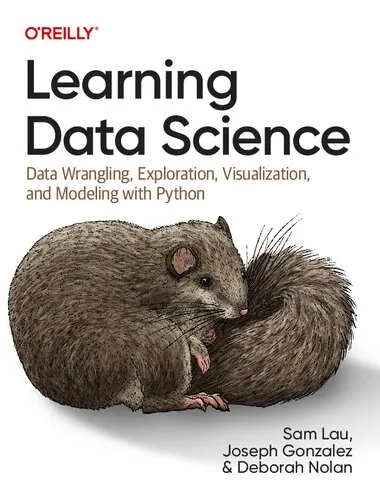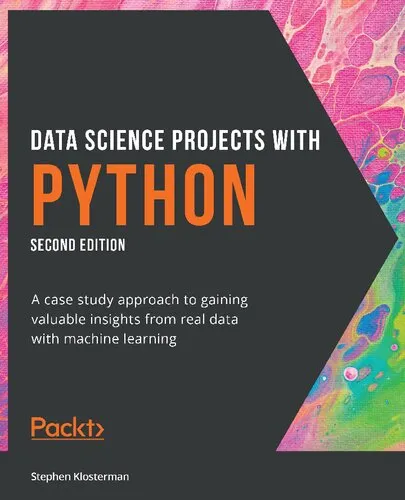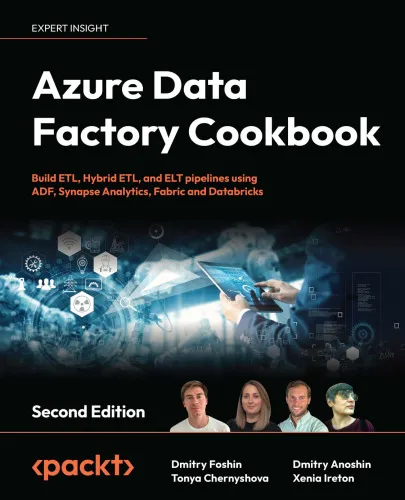Building ETL Pipelines with Python
4.0
بر اساس نظر کاربران

شما میتونید سوالاتتون در باره کتاب رو از هوش مصنوعیش بعد از ورود بپرسید
هر دانلود یا پرسش از هوش مصنوعی 2 امتیاز لازم دارد، برای بدست آوردن امتیاز رایگان، به صفحه ی راهنمای امتیازات سر بزنید و یک سری کار ارزشمند انجام بدینکتاب های مرتبط:
خلاصه تحلیلی کتاب
کتاب Building ETL Pipelines with Python اثری تخصصی و عمیق در زمینه طراحی، پیادهسازی و بهینهسازی فرآیندهای ETL با استفاده از زبان برنامهنویسی Python است. این کتاب با رویکردی نظاممند، خواننده را از مبانی نظری دادهکاوی و Data Engineering، تا مراحل عملی توسعه و تست Pipelineها هدایت میکند.
محتوای کتاب با تمرکز بر الگوهای معماری، مدیریت منابع داده، و استفاده از کتابخانههای محبوب Python، به تحلیل و شفافسازی هر گام پرداخته و مثالهای واقعی و کاربردی را برای انتقال مفاهیم ارائه میکند. با این رویکرد، مخاطب میتواند شناختی جامع از نحوه تعامل ابزارها و چگونگی تبدیل داده خام به داده آماده تحلیل پیدا کند.
از آنجا که در دنیای فناوری امروز، کیفیت و کارآمدی Pipelineهای ETL نقش اساسی در موفقیت پروژهها دارد، این کتاب با ارائه جزئیات فنی و توضیح منطق پشت هر تصمیم، منبعی ارزشمند برای پژوهشگران، متخصصان داده و علاقهمندان جدی به حوزه مهندسی داده محسوب میشود.
نکات کلیدی و کاربردی
یکی از نکات برجسته در کتاب، تمرکز بر اصول مهندسی داده است و اینکه چگونه Python میتواند بهعنوان ابزار اصلی در توسعه Pipelineها استفاده شود. نویسنده مراحل Extract، Transform و Load را با مثالهای عینی و جزئیات فنی شرح داده است.
کتاب به معرفی کتابخانهها و Frameworkهای مهم، از جمله Pandas، SQLAlchemy و Airflow میپردازد و نکات مربوط به بهینهسازی Performance، امنیت داده و یکپارچگی سیستمها را بررسی میکند.
با تأکید بر بهترین شیوههای (Best Practices) توسعه، خواننده با موضوعاتی چون مدیریت خطا (Error Handling)، Logging و Version Control در پروژههای ETL آشنا میشود. همچنین رویکردهای مدرن برای کار با Big Data و ذخیرهسازی در Cloud بررسی شده است.
نقلقولهای ماندگار
در طول مطالعه کتاب، خواننده با بخشهایی مواجه میشود که پیامهای مهم و انگیزشی را منتقل میکنند. این نقلقولها میتوانند الهامبخش برای متخصصان داده و پژوهشگران باشند.
برای ساخت Pipeline پایدار، هر خط کد باید بهاندازه یک قطعه سازه مطمئن باشد.
نامشخص
کیفیت داده، همان کیفیت تصمیمات سازمان را تعیین میکند.
نامشخص
چرا این کتاب اهمیت دارد
اهمیت Building ETL Pipelines with Python در ارائه یک مسیر آموزشی و عملی برای افرادی است که به دنبال تسلط واقعی بر فرآیندهای ETL هستند. این کتاب تنها یک راهنمای فنی ساده نیست، بلکه فلسفه پشت طراحی سیستمهای دادهای کارآمد را توضیح میدهد.
با رشد حجم دادهها و نیاز به تحلیل سریع و دقیق، اهمیت شناخت صحیح و اجرای درست مراحل ETL بیش از پیش احساس میشود. نویسنده با بهرهگیری از تجربه عملی (اطلاعات نامشخص، منبع معتبر در دسترس نیست)، چارچوبی ارائه کرده که میتواند در سازمانهای کوچک و بزرگ بهکار رود.
این کتاب پلی میان مباحث تئوری و تکنیکهای عملی فراهم میکند و به افراد کمک میکند تا نهتنها ابزارها را یاد بگیرند بلکه چرایی استفاده از هر رویکرد را نیز درک کنند.
نتیجهگیری الهامبخش
کتاب Building ETL Pipelines with Python نهتنها یک اثر فنی ارزشمند برای متخصصان داده است، بلکه الهامبخش هر فردی است که به دنبال ارتقاء مهارتهای خود در حوزه پردازش و تحلیل داده میباشد. با بهرهگیری از مفاهیم و تکنیکهای ارائه شده در آن، میتوان سیستمهایی ساخت که دادهها را به شکلی بهینه و قابل اعتماد منتقل و پردازش کنند.
اگر بهدنبال یک منبع معتبر و جامع برای یادگیری ETL همراه با کاربرد Python هستید، مطالعه این کتاب را در اولویت قرار دهید. همچنین توصیه میکنم برداشت
Analytical Summary
The book Building ETL Pipelines with Python offers a deep and methodical exploration of how to design, implement, and optimize extraction, transformation, and loading processes in modern data engineering. Written with precision, it bridges the gap between conceptual frameworks of ETL and the hands-on coding practices that bring them to life. This journey is both technical and strategic, ensuring that readers form a comprehensive view of the end-to-end pipeline landscape.
ETL workflows represent a critical backbone for data-driven organizations, enabling reliable migration of data from multiple sources into well-structured destinations. In this guide, secondary keywords such as “data engineering” and “Python-based ETL workflows” are woven organically into discussions, underscoring their relevance and synergy with the primary theme. Through illustrative examples and clear explanations, the content enables academics, analysts, and infrastructure architects alike to apply theoretical knowledge to practical problems.
Information about the publication year and any formal awards associated with the book is currently unavailable due to the absence of a reliable public source. Nevertheless, its value is derived from its clarity, methodical coverage, and actionable insights rather than accolades or marketing claims.
Key Takeaways
Readers will leave with a thorough grasp of how Python can serve as a powerful tool for ETL pipeline construction, from data ingestion to complex transformations and efficient loading into target systems.
They will learn to identify appropriate libraries and modules that streamline ETL implementations, design pipelines that are both scalable and maintainable, and apply patterns that accommodate evolving data landscapes.
Equally important is the focus on operational excellence—ensuring data quality, monitoring performance metrics, and deploying strategies for automated fault handling in production environments.
The integrated approach fuses theory with practice, making Building ETL Pipelines with Python a reference that grows in utility as projects scale and diversify.
Memorable Quotes
“A pipeline is more than the sum of its parts; it is a living system that evolves with the data it moves.”Unknown
“Python’s versatility allows data engineers to weave together diverse tools into cohesive, resilient ETL processes.”Unknown
“Building ETL pipelines requires both technical rigor and operational empathy.”Unknown
Why This Book Matters
Building ETL Pipelines with Python stands at the intersection of programming proficiency and strategic data management, making it indispensable for professionals aiming to master ETL workflows.
In an age where data volumes are skyrocketing and formats are fragmenting, the toolkit and methodologies covered in this guide offer resilience against change. The combination of Python’s rich ecosystem with disciplined engineering practices enables practitioners to solve complex integration challenges systematically.
Beyond just “how-to” recipes, this book cultivates a mindset for continuous improvement, proactive monitoring, and adaptive architecture—qualities crucial to any sustainable data infrastructure.
Inspiring Conclusion
By the time you close the pages of Building ETL Pipelines with Python, you will have expanded your technical skill set and strategic thinking about ETL systems.
This is not merely a handbook—it is an invitation to build, refine, and share your own robust pipelines that serve real-world needs. Whether you are a data engineer, academic researcher, or technology leader, the principles discussed provide a foundation for both immediate application and long-term growth.
Your next step is clear: take these insights, experiment with them in your own environment, engage in discussions with peers, and contribute to the evolving practice of modern ETL. The journey of transforming data into value continues, and now you have a solid roadmap to guide you.
دانلود رایگان مستقیم
شما میتونید سوالاتتون در باره کتاب رو از هوش مصنوعیش بعد از ورود بپرسید
دسترسی به کتابها از طریق پلتفرمهای قانونی و کتابخانههای عمومی نه تنها از حقوق نویسندگان و ناشران حمایت میکند، بلکه به پایداری فرهنگ کتابخوانی نیز کمک میرساند. پیش از دانلود، لحظهای به بررسی این گزینهها فکر کنید.
این کتاب رو در پلتفرم های دیگه ببینید
WorldCat به شما کمک میکنه تا کتاب ها رو در کتابخانه های سراسر دنیا پیدا کنید
امتیازها، نظرات تخصصی و صحبت ها درباره کتاب را در Goodreads ببینید
کتابهای کمیاب یا دست دوم را در AbeBooks پیدا کنید و بخرید
1134
بازدید4.0
امتیاز0
نظر98%
رضایتنظرات:
4.0
بر اساس 0 نظر کاربران
Questions & Answers
Ask questions about this book or help others by answering
No questions yet. Be the first to ask!
